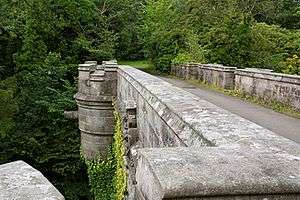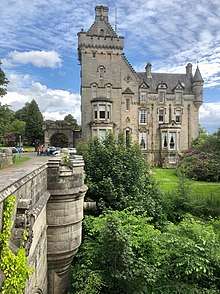Overtoun Bridge
Overtoun Bridge is a category B-listed structure over the Overtoun Burn on the approach road to Overtoun House,[lower-alpha 1] near Dumbarton in West Dunbartonshire, Scotland. It was completed in 1895 to a design by the landscape architect H. E. Milner.

Since 2005, media publicity has been given to reports that a number of dogs had fallen or leapt from Overtoun Bridge, being injured or dying when landing on the rocks 50 feet (15 m) below; the bridge has also been the site of a murder and an attempted suicide. There have been claims of ghosts or other supernatural causes; researchers have described the story of dogs committing suicide off the bridge as an example of folklore and urban legend. Natural explanations include the dogs being attracted to the scent or sounds of animals in undergrowth, and losing their balance on sloping surfaces of the bridge's parapet.
History and construction

Lord Overtoun had inherited Overtoun House and the estate in 1891. He purchased the neighbouring Garshake estate to the west of his lands in 1892.[2] Carriages had been unable to gain access to the Overtoun mansion along the old eastern approach road as the incline was too steep;[3] work commenced on constructing a new driveway as soon as Garshake was acquired.[4]
Designed by the civil engineer and landscape architect H. E. Milner, the bridge was constructed using rough-faced ashlar and was completed in June 1895. It comprises three arches: a large central arch spanning a deep valley at the bottom of which flows the Overtoun Burn, flanked on each side by lower, smaller pedestrian arches.[4]
Unexplained dog deaths

According to Glasgow Skeptics, a tale of dogs leaping to their deaths from this bridge has been on the internet since about 2005 when it was mentioned in passing on a forum about hidden sights in Glasgow. It gained prominence in 2006 when the Daily Mail wrote an article about it.[5] Since then the reported deaths have received international media attention.
The canine psychologist David Sands examined sight, smell and sound factors. He concluded that although it was not a definitive answer, the apparently even surrounding ground and foliage masks the drop on the other side, especially to dogs with their lowered point of view, and makes it appear that the whole area is one even plane. That, combined with the odour from male mink urine was possibly luring dogs to jump to the other side.[6] A local hunter, John Joyce, who has lived in the area for 50 years, disagreed with the "Scent Theory". He said in 2014, "[T]here is no mink around here. I can tell you that with absolute certainty."[7]
The canine deaths have prompted claims of paranormal activity at the bridge.[8][9] Paranormal investigator Brian Dunning asked, is it possible for "a dog to commit premeditated suicide"? David Sands stated "it's impossible for them to commit what we humans would call suicide." David Sexton from Royal Society for the Protection of Birds and Wildlife investigated the bridge further and discovered that the end of the bridge that dogs are "said to favor" contains "nests of mice, squirrels, and minks". Sands set up an experiment with ten dogs, "[O]n a field prepared with canisters containing mouse, squirrel, and mink scent, one of the dogs went to the squirrel scent, two preferred to play with their masters, and the remaining seven all went straight for the mink scent, many of them quite dramatically."[10]
In 2019 the owners of Overtoun House, Bob and Melissa Hill, were interviewed for The New York Times. They said that in the 17 years they had lived there they had seen a number of dogs which become agitated, jumped up and fell from the bridge. Bob Hill, a pastor from Texas, gave a natural explanation: "The dogs catch the scent of mink, pine martens or some other mammal and then they will jump up on the wall of the bridge. And because it’s tapered, they will just topple over." At the same time, he thought the grounds of the house had a spiritual quality, and the supernatural was common in the lives of people in Scotland.[6]
Other events
In October 1994, a man threw his two-week-old son to his death from the bridge because he believed that his son was an incarnation of the Devil. He then attempted to commit suicide several times, first by attempting to jump off the bridge, later by slashing his wrists.[11]
References
Notes
- Category B structures are "buildings of regional or more than local importance, or major examples of some particular period, style or building type which may have been altered".[1]
Citations
- "What is Listing?: Categories of listed building", Historic Environment Scotland, retrieved 29 March 2019
- "Overtoun: Site history", An Inventory of Gardens and Designed Landscapes in Scotland, Historic Scotland, archived from the original on 14 April 2015, retrieved 14 April 2015
- "Overtoun House", West Dunbartonshire Council, archived from the original on 14 April 2015, retrieved 14 April 2015
- "Overtoun House, Bridge at Garshake Drive (Ref:24908)", Historic Scotland, archived from the original on 9 April 2015, retrieved 9 April 2015
- "Flogging a dead dog? - Glasgow Skeptics". Glasgow Skeptics. The Wayback Machine. Archived from the original on 28 March 2019. Retrieved 28 March 2019.
- Yeginsu, Ceylan (27 March 2019). "'Dog Suicide Bridge': Why Do So Many Pets Keep Leaping Into a Scottish Gorge?". Retrieved 27 March 2019 – via NYTimes.com.
- "Lost Giants of Georgia and Bridge of Death", The Unexplained Files, season 2, episode 8, 16 September 2014, The Science Channel
- Midgley, Dominic (25 June 2015), "What's caused 600 dogs to hurl themselves off this bridge?", Daily Express
- Khan, Maria. "Scotland: 600 dogs mysteriously jump off haunted suicide Overtoun bridge". International Business Times. Retrieved 9 July 2017.
- Dunning, Brian (24 July 2012). "The Suicide Dogs of Overtoun Bridge". Skeptoid. Retrieved 27 March 2019.
- "Father who threw 'devil' baby from bridge sent to Carstairs". The Herald. 1 February 1995.
External links
| Wikimedia Commons has media related to Overtoun Bridge. |